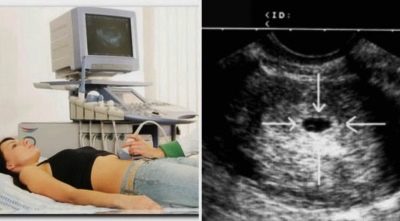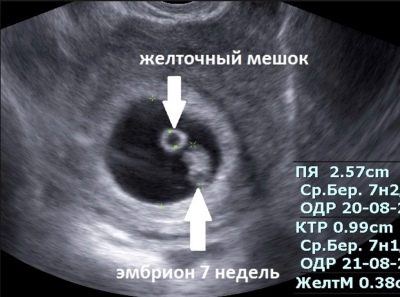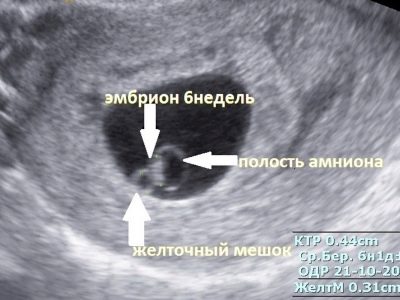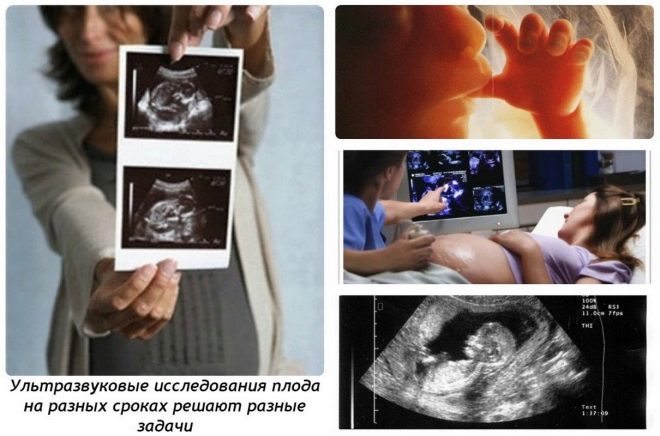Ultrasound in early pregnancy
With the help of ultrasound, you can determine pregnancy quite early. Many future moms have a lot of questions about how this research is conducted and whether it can be dangerous for their baby. This article will help to understand this.
Pros and cons of research
Currently, there are a variety of methods of ultrasound, allowing to establish pregnancy even at the earliest stages. The screening is shown to all women who have a suspicion that they will soon become mothers. This research is extremely important and necessary.
Ultrasound diagnosis is baseline in establishing pregnancy. Conducting it at certain stages of fetal growth is mandatory. This allows you to monitor the dynamics of its prenatal development and to identify various anomalies, as well as deviations at the very early stages.
However, there are also disadvantages of this procedure. Of course, these include the human factor.
European doctors have found that the discrepancy in the evaluation of the results obtained can reach 20%. This is a fairly high figure, especially when it comes to pregnant women and their future babies.
There is also a risk of infection of the baby during the ultrasound through the vagina. Immediately it should be noted that this situation occurs extremely rarely and depends entirely on the competence of the doctor conducting this study. If the doctor has proper experience and education, then such a situation is almost impossible.
Expectant mothers should remember that ultrasound is one of several diagnostic methods and is performed by humans. This implies that the results obtained are not 100% reliable. In some cases, they do not completely coincide with the actual health indicators of the future mother and baby. In this case, it is required Mandatory rechecking and conducting research with another specialist.
Kinds
Methods of ultrasound in the early stages can be very different. The choice of research depends on the level of material and technical base of a medical institution. It must be said that in recent times even the most ordinary district gynecological clinics are equipped with fairly modern devices.
Many future moms do not know which method is better to detect pregnancy in the early stages. This choice is individual and depends on each specific situation. Usually the technique of the first ultrasound necessarily agreed with the obstetrician-gynecologist, who will lead a woman during the entire period of her pregnancy.
Examinations can be performed using various types of sensors. Doctors call the vaginal probe study transvaginal Ultrasound. You can also conduct research through the abdomen. This method is called transabdominal.
The need for an ultrasound of the uterus or pelvis is determined individually by an obstetrician-gynecologist. To do this, all the abnormalities of the genital organs of a pregnant woman are evaluated. The doctor, who will observe the future mommy in the future, is in this period for her the necessary diagnostic scheme.As a rule, in most cases, combined research methods are used.
What indicators are evaluated?
Future moms should understand a few basic concepts that are used by both ultrasound doctors and obstetrician-gynecologists. Often they use the term "Obstetric gestational age". This concept implies a term of fetal development. It is always calculated in weeks and days, and not monthly.
Many doctors of ultrasound diagnostics use the term “embryonic term”, which significantly confuses the future mother. It should be remembered that only the obstetric method of calculation is used to estimate the duration of pregnancy. Modern ultrasound machines automatically calculate it for the basic parameters that are entered before the procedure of the study. Further To assess the course of pregnancy is also used obstetric term.
Ultrasound in the earliest period of intrauterine development is done for:
- establishing gestational eggs in the uterus, which means pregnancy;
- determine the stage of development of the embryo during its development;
- detection of specific signs of the "frozen" course of pregnancy;
- the establishment of various disorders and fetal abnormalities.
About gestational egg
It is also called fetal. This is a characteristic criterion, speaking about the presence of a woman's pregnancy. Most often, it can be identified only in five weeks of intrauterine development. Some qualified and experienced specialists can detect the presence of gestational eggs in the uterus already for a period of 3 weeks.
Usually during this period you can set gestational age with an accuracy of about 1 week. Any deviations in development at this stage is extremely difficult to identify. The first ultrasound will only show pregnancy, but will not be able to identify all developmental abnormalities in the fetus. Their doctors determine a little later - in the second and third trimester of carrying a baby.
Experts evaluate several key parameters detected at the earliest stages of gestation.
They allow doctors to understand whether the fetal development is normal. The development of the embryo can be determined by determining its diameter. For this, it suffices, as a rule, only one dimension.
The average diameter allows you to determine the size of the gestational eggs more accurately. This requires at least three measurements. Many mummies are interested in why it is also impossible to measure only one parameter. Such a study will not be informative and will not allow to obtain an accurate result.
If the gestational egg is determined at 4 weeks and three days after the first day of the last menstruation, then its size is usually 2-3 mm. At 5-6 weeks of prenatal development from the same day of calculation, the diameter is already increased to 0.5 cm. Thus, the definition of this parameter is quite informative and allows you to track the dynamics of fetal growth.
These figures will also help expectant mothers calculate the approximate menstrual period of pregnancy. Usually, this term doctors call obstetric period, but in the first weeks of carrying the unborn child. In this case, to determine the menstrual age, the average diameter of the ovum (in mm) should be added 30. If this average diameter is more than 16 mm, then 35 is added to the value.
The growth of gestational eggs in the first trimester is quite fast. This feature is due to nature. It is at the earliest stages of the future baby that all vital organs are laid. This time is very important for every child.
The gestational egg grows at a rate of 1.8-2 mm every two days from 4 to 9 weeks of intrauterine development.It should be noted that this indicator to assess the development of the future baby is not evaluated, but is informative in nature.
Doctors identify several clinical situations that should alert future moms. If, with a size of 15 to 25 mm, the gestational egg in the uterus is not detected, then this may be a sign of "frozen" development of pregnancy. This feature is extremely unfavorable. If this situation has occurred, then a pregnant woman should not panic in the first place. In this case, it is required mandatory control of ultrasound after 7 days.
If the size of the ovum is too large for a certain period, this is also a very unfavorable symptom. Doctors believe that this may be a manifestation of the pathological course of pregnancy. This condition occurs when "Frozen" pregnancy or at empty egg syndrome. Only obstetrician-gynecologists reveal these pathologies. In this case it is absolutely impossible to rely on only one ultrasound result.
The size of the ovum should gradually increase over time. If there is a reverse process, then this may be an indirect sign of low water. It should be noted that the amount of amniotic fluid using ultrasound is determined much later. Typically, such a study is carried out only at 18-20 weeks of intrauterine development of the fetus.
About yolk sac
This anatomical formation appears before the full formation of the embryo. Doctors consider the appearance of this clinical sign as reliable confirmation of the presence of uterine pregnancy in the female body. Some unqualified ultrasound diagnostics at this stage may be mistaken and not “see” an ectopic pregnancy.
The yolk sac is located between the chorion and the amnion. Subsequently, the placenta and fetal membranes will develop from these anatomical structures. The specific place in which the yolk sac is located is called chorionic space.
The size of this formation is related to the parameters of the gestational egg. If the gestational egg has a size of 0.5 cm, then the yolk sac may be about 6 mm. A variant of the norm can be considered the size from 3 to 5 mm.
The largest size of the yolk sac is at 10 weeks of intrauterine development. By this period, it grows up to 0.5 cm. In the future, this formation also participates in organogenesis - the intestines of the unborn child are formed from it.
About amnion
Doctors consider this formation to be a special membrane (shell) that is located in the fetal egg. As a rule, this anatomical formation is clearly visible until 11-12 weeks of intrauterine development of the fetus. During this gestation period, fetal sizes are about 5-7 mm. Full completion of the formation of fetal membranes occurs only at the end of the 16th week of intrauterine development.
In addition to the yolk sac, amnion and the ovum, ultrasound doctors determine a number of other important indicators. One of these parameters is determination of coccyx parietal size. This indicator is described in the conclusion with a few letters. It may be called KTP or CRL.
The KTP parameter allows you to define embryo length. It should be noted that in determining this indicator, ultrasound specialists quite often make various mistakes. In some cases, technical errors of the devices may also lead to an incorrect result. It should be noted that this is found in cases when outdated equipment is used for ultrasound diagnostics or an inexperienced doctor conducts research.
Using a correctly defined coccyx-parietal size, one can determine exact gestational age. The accuracy of the determination in this case can be even 3-5 days. If the size of the ovum is already 0.5-1 cm, then the immediate size of the embryo can be determined, which becomes equal to 1-2 mm.In the future, every day the future man grows at a speed of about 1 mm.
About heartbeat
Fetal heartbeat - Another characteristic criterion, which is determined in early pregnancy. This indicator is extremely important. Blood circulation in the fetus helps to assess its growth and development. Determine the heartbeat of the fetus can already be at a gestational age of 6 weeks.
Sometimes this figure can not be determined. Panic in this case is also not worth it. In such a situation, a second ultrasound scan is required. It is carried out, as a rule, in 4-6 days.
Heart rate as the embryo grows. Up to 6 weeks of intrauterine development, this figure is usually 100-116 beats per minute. By week 9, the heart rate rises to 145-160 beats per minute. After 9 weeks, this figure starts to decline slightly.
A decrease in heart rate in the early stages of intrauterine development is, as a rule, an unfavorable indicator. Doctors call such a condition bradycardia. The appearance of this symptom may indicate a pathological course of pregnancy and even its “fading”. Any reduction in heart rate requires urgent intervention by gynecologists.
In early pregnancy, bradycardia can be determined by several criteria:
- if the coccyx parietal size is less than 0.5 cm, and the heart rate is less than 80 beats per minute;
- if the coccyx parietal size is between 0.5 cm and 9 mm, and the heart rate is less than 100 beats per minute;
- if the coccyx parietal size is 1-1.5 cm, and the heart rate does not exceed 110 beats per minute.
About the collar zone
The size of the neck area is another indicator that is used to determine the size of the embryo. This anatomical formation is a collection of lymph between the skin and the soft tissues of the embryo. The normal parameters of this zone are an important criterion for evaluating various chromosomal pathologies that can develop in the fetus.
The definition of this indicator is carried out, as a rule, in 11-14 weeks. This test is part of a genetic screening. Also for additional diagnostics a number of biochemical studies are carried out. This helps to establish the presence in the female body of any genetic abnormalities.
It is very important to conduct research during a certain period of pregnancy. Only a timely assessment of the results allows us to assess the real state of the fetus in the womb. For more late dates, another indicator is used. It is called a neck roller.
Measurement of the thickness of the neck area is compared with the coccyx parietal size equal to 45-84 mm. Compliance with the time criteria is very important and due to the physiological development of the lymphatic system. Metabolism in the lymph proceeds very quickly. Normally, the index of the thickness of the collar area in this period of pregnancy is 3 mm. Pathological value can be considered the size of 0.5 cm in 16-18 weeks and more than 6 mm in 19-24 weeks.
About the nasal bone
Nasal bone is another indicator evaluated by doctors in the very early stages of pregnancy. Such research helps to identify various genetic abnormalities, including Down's disease in the very early stages. Usually the size of the nasal bone is determined in the fetus at 11-14 weeks. If an unborn child is missing or less than 2.5 mm by this time, then this may be the first sign of Down's disease.
How many times can you do?
Obstetricians and gynecologists identify several important periods of the very early childbearing period, when research is necessary. The first examination can be carried out as early as 2-5 weeks from the moment of conception. Doctors call this period of development of the future baby the conception phase, or concept.As a rule, an ultrasound scan at this time is only indicative.
The next stage is embryonic. It occurs at 6-10 weeks of intrauterine development of the future baby. At this time, the fetus is already quite well defined in the uterus. At the end of 10 and up to 12 weeks, the final stages of the main development of the future baby pass. The initial process of laying the internal organs and systems of the baby, as a rule, is completed. Doctors call this phase fetal.
Reviews of many mothers show that the first ultrasound was the most significant and exciting for them. After all, it was at this time that the doctor uttered to them the phrase that they would soon become mothers.
Many pregnant women also emphasize the importance of ultrasound in the very early stages of development in their womb of the future baby.
Signs of a Multiple Pregnancy
Usually, it is possible to accurately detect the presence of twins in the uterus only at 8-12 weeks of intrauterine development. In this case, several embryos are well defined in the uterus. They can be located in various parts of the uterine space. It depends on where exactly the implantation occurred.
To determine the heartbeat of twins can, as a rule, somewhat later than during pregnancy with one baby. It is possible to establish a heartbeat, but to differentiate how many hearts beat is a rather difficult task. Usually the second or third heart becomes audible only by the 20th week of pregnancy. In the early stages of twins, various pathologies are rather difficult to determine.
Is it harmful to the fetus?
Around the ultrasound there are a huge number of opinions and various myths. Many future mothers are worried about the possible harm that this study can do to the baby. There is currently no reliable data on the pronounced negative effect of ultrasound on the developing fetus.
Ultrasound screening is performed in many countries. These methods allow you to identify various pathologies of pregnancy in the earliest terms. Without performing an ultrasound diagnosis, genetic screening would not have been possible.
If the future mother had relatedness to chromosomal diseases, an ultrasound scan is also a necessity.
If a woman has diseases of the genitals, then transvaginal ultrasound in the early stages of pregnancy can cause her to have a small amount of blood from the genital tract. This condition can not lead to any complications for the fetus. However, it is worth remembering that if a woman has genital diseases, the stage of exacerbation is acute, then before conducting a study they must be cured.
If the future mommy has any inflammatory diseases, then transvaginal examination can also lead to a number of complications. Some women have a different discharge after ultrasound. Their appearance is possible mainly in acute coleitis or vaginitis, which are in the acute stage.
If a pregnant woman has any unpleasant symptoms in the perineal area, then she must warn her doctor about this before conducting the study.
Ultrasound should be performed by all pregnant women at the earliest stages. This not only makes it possible to detect pregnancy in a timely manner, but also to determine the pathological conditions that the future mother has.
Often, such research is also not worth it. For ultrasound there are certain regulated deadlines.
The importance of ultrasound in early pregnancy, see the following video.








































